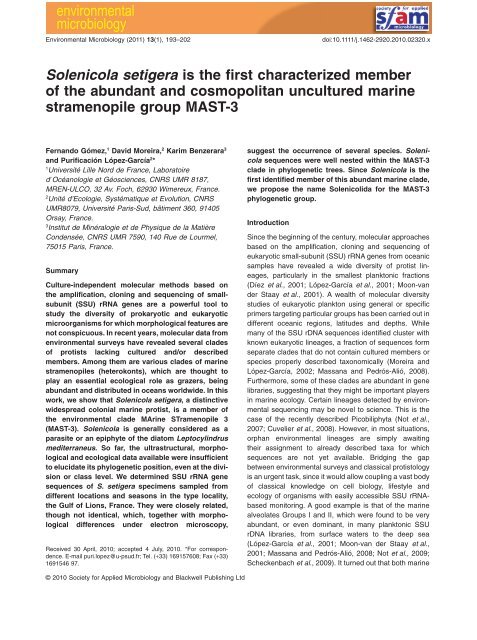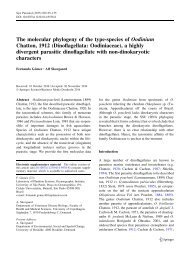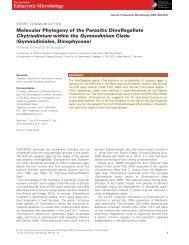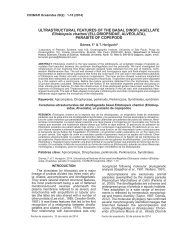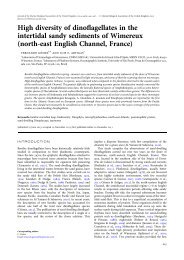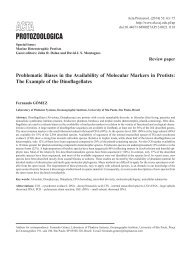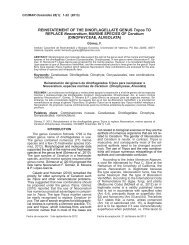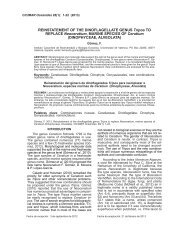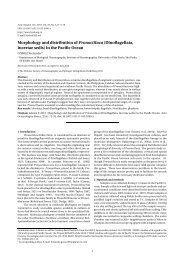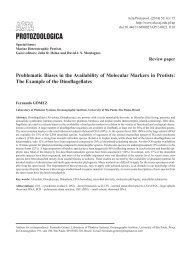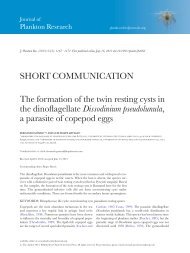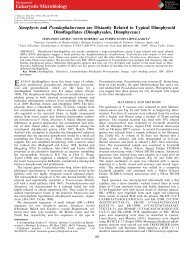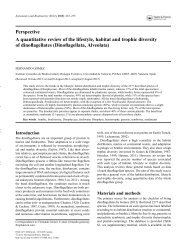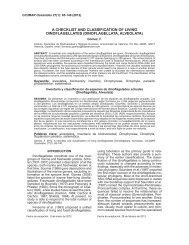Solenicola setigera is the first characterized memberof the abundant and cosmopolitan uncultured marine stramenopile group MAST-3
Culture-independent molecular methods based on the amplification, cloning and sequencing of smallsubunit (SSU) rRNA genes are a powerful tool to study the diversity of prokaryotic and eukaryotic microorganisms for which morphological features are not conspicuous. In recent years, molecular data from environmental surveys have revealed several clades of protists lacking cultured and/or described members. Among them are various clades of marine stramenopiles (heterokonts), which are thought to play an essential ecological role as grazers, being abundant and distributed in oceans worldwide. In this work, we show that Solenicola setigera, a distinctive widespread colonial marine protist, is a member of the environmental clade MArine STramenopile 3 (MAST-3). Solenicola is generally considered as a parasite or an epiphyte of the diatom Leptocylindrus mediterraneus. So far, the ultrastructural, morphological and ecological data available were insufficient to elucidate its phylogenetic position, even at the division or class level. We determined SSU rRNA gene sequences of S. setigera specimens sampled from different locations and seasons in the type locality, the Gulf of Lions, France. They were closely related, though not identical, which, together with morphological differences under electron microscopy, suggest the occurrence of several species. Solenicola sequences were well nested within the MAST-3 clade in phylogenetic trees. Since Solenicola is the first identified member of this abundant marine clade, we propose the name Solenicolida for the MAST-3 phylogenetic group.
Culture-independent molecular methods based on
the amplification, cloning and sequencing of smallsubunit
(SSU) rRNA genes are a powerful tool to
study the diversity of prokaryotic and eukaryotic
microorganisms for which morphological features are
not conspicuous. In recent years, molecular data from
environmental surveys have revealed several clades
of protists lacking cultured and/or described
members. Among them are various clades of marine
stramenopiles (heterokonts), which are thought to
play an essential ecological role as grazers, being
abundant and distributed in oceans worldwide. In this
work, we show that Solenicola setigera, a distinctive
widespread colonial marine protist, is a member of
the environmental clade MArine STramenopile 3
(MAST-3). Solenicola is generally considered as a
parasite or an epiphyte of the diatom Leptocylindrus
mediterraneus. So far, the ultrastructural, morphological
and ecological data available were insufficient
to elucidate its phylogenetic position, even at the division
or class level. We determined SSU rRNA gene
sequences of S. setigera specimens sampled from
different locations and seasons in the type locality,
the Gulf of Lions, France. They were closely related,
though not identical, which, together with morphological
differences under electron microscopy,
suggest the occurrence of several species. Solenicola
sequences were well nested within the MAST-3
clade in phylogenetic trees. Since Solenicola is the
first identified member of this abundant marine clade,
we propose the name Solenicolida for the MAST-3
phylogenetic group.
Create successful ePaper yourself
Turn your PDF publications into a flip-book with our unique Google optimized e-Paper software.
Environmental Microbiology (2011) 13(1), 193–202<br />
doi:10.1111/j.1462-2920.2010.02320.x<br />
<strong>Solenicola</strong> <strong>setigera</strong> <strong>is</strong> <strong>the</strong> <strong>first</strong> <strong>characterized</strong> member<br />
of <strong>the</strong> <strong>abundant</strong> <strong>and</strong> <strong>cosmopolitan</strong> <strong>uncultured</strong> <strong>marine</strong><br />
<strong>stramenopile</strong> <strong>group</strong> <strong>MAST</strong>-3emi_2320 193..202<br />
Fern<strong>and</strong>o Gómez, 1 David Moreira, 2 Karim Benzerara 3<br />
<strong>and</strong> Purificación López-García 2 *<br />
1<br />
Université Lille Nord de France, Laboratoire<br />
dOcéanologie et Géosciences, CNRS UMR 8187,<br />
MREN-ULCO, 32 Av. Foch, 62930 Wimereux, France.<br />
2<br />
Unité d’Ecologie, Systématique et Evolution, CNRS<br />
UMR8079, Université Par<strong>is</strong>-Sud, bâtiment 360, 91405<br />
Orsay, France.<br />
3<br />
Institut de Minéralogie et de Physique de la Matière<br />
Condensée, CNRS UMR 7590, 140 Rue de Lourmel,<br />
75015 Par<strong>is</strong>, France.<br />
Summary<br />
Culture-independent molecular methods based on<br />
<strong>the</strong> amplification, cloning <strong>and</strong> sequencing of smallsubunit<br />
(SSU) rRNA genes are a powerful tool to<br />
study <strong>the</strong> diversity of prokaryotic <strong>and</strong> eukaryotic<br />
microorgan<strong>is</strong>ms for which morphological features are<br />
not conspicuous. In recent years, molecular data from<br />
environmental surveys have revealed several clades<br />
of prot<strong>is</strong>ts lacking cultured <strong>and</strong>/or described<br />
members. Among <strong>the</strong>m are various clades of <strong>marine</strong><br />
<strong>stramenopile</strong>s (heterokonts), which are thought to<br />
play an essential ecological role as grazers, being<br />
<strong>abundant</strong> <strong>and</strong> d<strong>is</strong>tributed in oceans worldwide. In th<strong>is</strong><br />
work, we show that <strong>Solenicola</strong> <strong>setigera</strong>, a d<strong>is</strong>tinctive<br />
widespread colonial <strong>marine</strong> prot<strong>is</strong>t, <strong>is</strong> a member of<br />
<strong>the</strong> environmental clade MArine STramenopile 3<br />
(<strong>MAST</strong>-3). <strong>Solenicola</strong> <strong>is</strong> generally considered as a<br />
parasite or an epiphyte of <strong>the</strong> diatom Leptocylindrus<br />
mediterraneus. So far, <strong>the</strong> ultrastructural, morphological<br />
<strong>and</strong> ecological data available were insufficient<br />
to elucidate its phylogenetic position, even at <strong>the</strong> div<strong>is</strong>ion<br />
or class level. We determined SSU rRNA gene<br />
sequences of S. <strong>setigera</strong> specimens sampled from<br />
different locations <strong>and</strong> seasons in <strong>the</strong> type locality,<br />
<strong>the</strong> Gulf of Lions, France. They were closely related,<br />
though not identical, which, toge<strong>the</strong>r with morphological<br />
differences under electron microscopy,<br />
Received 30 April, 2010; accepted 4 July, 2010. *For correspondence.<br />
E-mail puri.lopez@u-psud.fr; Tel. (+33) 169157608; Fax (+33)<br />
1691546 97.<br />
suggest <strong>the</strong> occurrence of several species. <strong>Solenicola</strong><br />
sequences were well nested within <strong>the</strong> <strong>MAST</strong>-3<br />
clade in phylogenetic trees. Since <strong>Solenicola</strong> <strong>is</strong> <strong>the</strong><br />
<strong>first</strong> identified member of th<strong>is</strong> <strong>abundant</strong> <strong>marine</strong> clade,<br />
we propose <strong>the</strong> name Solenicolida for <strong>the</strong> <strong>MAST</strong>-3<br />
phylogenetic <strong>group</strong>.<br />
Introduction<br />
Since <strong>the</strong> beginning of <strong>the</strong> century, molecular approaches<br />
based on <strong>the</strong> amplification, cloning <strong>and</strong> sequencing of<br />
eukaryotic small-subunit (SSU) rRNA genes from oceanic<br />
samples have revealed a wide diversity of prot<strong>is</strong>t lineages,<br />
particularly in <strong>the</strong> smallest planktonic fractions<br />
(Díez et al., 2001; López-García et al., 2001; Moon-van<br />
der Staay et al., 2001). A wealth of molecular diversity<br />
studies of eukaryotic plankton using general or specific<br />
primers targeting particular <strong>group</strong>s has been carried out in<br />
different oceanic regions, latitudes <strong>and</strong> depths. While<br />
many of <strong>the</strong> SSU rDNA sequences identified cluster with<br />
known eukaryotic lineages, a fraction of sequences form<br />
separate clades that do not contain cultured members or<br />
species properly described taxonomically (Moreira <strong>and</strong><br />
López-García, 2002; Massana <strong>and</strong> Pedrós-Alió, 2008).<br />
Fur<strong>the</strong>rmore, some of <strong>the</strong>se clades are <strong>abundant</strong> in gene<br />
libraries, suggesting that <strong>the</strong>y might be important players<br />
in <strong>marine</strong> ecology. Certain lineages detected by environmental<br />
sequencing may be novel to science. Th<strong>is</strong> <strong>is</strong> <strong>the</strong><br />
case of <strong>the</strong> recently described Picobiliphyta (Not et al.,<br />
2007; Cuvelier et al., 2008). However, in most situations,<br />
orphan environmental lineages are simply awaiting<br />
<strong>the</strong>ir assignment to already described taxa for which<br />
sequences are not yet available. Bridging <strong>the</strong> gap<br />
between environmental surveys <strong>and</strong> classical prot<strong>is</strong>tology<br />
<strong>is</strong> an urgent task, since it would allow coupling a vast body<br />
of classical knowledge on cell biology, lifestyle <strong>and</strong><br />
ecology of organ<strong>is</strong>ms with easily accessible SSU rRNAbased<br />
monitoring. A good example <strong>is</strong> that of <strong>the</strong> <strong>marine</strong><br />
alveolates Groups I <strong>and</strong> II, which were found to be very<br />
<strong>abundant</strong>, or even dominant, in many planktonic SSU<br />
rDNA libraries, from surface waters to <strong>the</strong> deep sea<br />
(López-García et al., 2001; Moon-van der Staay et al.,<br />
2001; Massana <strong>and</strong> Pedrós-Alió, 2008; Not et al., 2009;<br />
Scheckenbach et al., 2009). It turned out that both <strong>marine</strong><br />
© 2010 Society for Applied Microbiology <strong>and</strong> Blackwell Publ<strong>is</strong>hing Ltd
194 F. Gómez, D. Moreira, K. Benzerara <strong>and</strong> P. López-García<br />
alveolate <strong>group</strong>s corresponded to well-known parasitic<br />
lineages related to <strong>the</strong> dinoflagellates, Group I to <strong>the</strong><br />
Duboscquellida (Harada et al., 2007) <strong>and</strong> Group II to <strong>the</strong><br />
Syndiniales (Gunderson et al., 1999; Moreira <strong>and</strong> López-<br />
García, 2002; Guillou et al., 2008), which highlights <strong>the</strong><br />
importance of parasit<strong>is</strong>m in <strong>the</strong> <strong>marine</strong> ecosystem, particularly<br />
in <strong>the</strong> deep sea (Moreira <strong>and</strong> López-García,<br />
2003; Scheckenbach et al., 2009).<br />
Apart from <strong>the</strong> alveolates, o<strong>the</strong>r planktonic oceanic lineages<br />
detected <strong>abundant</strong>ly in SSU rRNA gene libraries<br />
remain to be associated to described organ<strong>is</strong>ms. Among<br />
<strong>the</strong>m are several clades of <strong>stramenopile</strong>s (heterokonts),<br />
whose sequences branch scattered among heterotrophic<br />
<strong>stramenopile</strong> taxa in phylogenetic trees. Heterotrophic<br />
pico- <strong>and</strong> nanoflagellates are essential players in aquatic<br />
food webs as grazers of bacteria <strong>and</strong> photosyn<strong>the</strong>tic<br />
prokaryotes <strong>and</strong> picoeukaryotes (Patterson, 1989; Arndt<br />
et al., 2000). Unfortunately, most of <strong>the</strong>m are not culturable<br />
<strong>and</strong> <strong>the</strong>ir small size <strong>and</strong> delicacy render morphological<br />
studies difficult. MArine STramenopiles (<strong>MAST</strong>)<br />
sequences are particularly frequent in clone libraries of<br />
surface <strong>marine</strong> picoplankton, where <strong>the</strong>y typically account<br />
for approximately 20% of all clones <strong>and</strong> up to 50% of<br />
sequences from <strong>uncultured</strong> <strong>group</strong>s (Massana et al., 2004;<br />
Not et al., 2009). Massana <strong>and</strong> colleagues (2004) defined<br />
<strong>group</strong>s <strong>MAST</strong>-1 to -12 based on phylogenetic analyses of<br />
environmental sequences. Two of <strong>the</strong>se lineages<br />
(<strong>MAST</strong>-3 <strong>and</strong> -4) were shown to correspond to bacterivorous<br />
heterotrophic flagellates locally <strong>abundant</strong> in a coastal<br />
Mediterranean system (Massana et al., 2002). <strong>MAST</strong>-3<br />
sequences formed <strong>the</strong> largest cluster, which was also<br />
highly diverse, <strong>and</strong> appeared in open sea <strong>and</strong> coasts from<br />
all <strong>the</strong> world ocean regions studied (Massana et al.,<br />
2004). Their high proportions on reverse transcribed SSU<br />
rRNA libraries suggest that <strong>MAST</strong>-3 flagellates are not<br />
only very <strong>abundant</strong> but also very active (Not et al., 2009).<br />
In contrast to o<strong>the</strong>r small pelagic prot<strong>is</strong>ts, <strong>Solenicola</strong><br />
<strong>setigera</strong> <strong>is</strong> known since <strong>the</strong> earliest studies on <strong>marine</strong><br />
plankton (Gran, 1904). They are small, 4–7 mm in diameter,<br />
but <strong>the</strong>y form colonies on siliceous tubes that facilitate<br />
<strong>the</strong> identification during routine phytoplankton<br />
analys<strong>is</strong>. Pavillard (1916) described S. <strong>setigera</strong> from <strong>the</strong><br />
coastal NW Mediterranean Sea <strong>and</strong> <strong>the</strong> siliceous tube<br />
was identified as <strong>the</strong> diatom Leptocylindrus (= Dactyliosolen)<br />
mediterraneus (Peragallo) Hasle (Hasle, 1975;<br />
Hasle <strong>and</strong> Syvertsen, 1997). The consortium of<br />
<strong>Solenicola</strong>–Leptocylindrus <strong>is</strong> ubiquitous in <strong>the</strong> world’s<br />
oceans from equatorial to Arctic <strong>and</strong> Antarctic waters,<br />
even under <strong>the</strong> ice (Fryxell, 1989; Gómez, 2007). Despite<br />
<strong>the</strong> widespread d<strong>is</strong>tribution of <strong>the</strong> <strong>Solenicola</strong>–<br />
Leptocylindrus consortia, both <strong>the</strong> actual nature of <strong>the</strong>ir<br />
constituents <strong>and</strong> <strong>the</strong> phylogenetic position of <strong>Solenicola</strong><br />
have been <strong>the</strong> subject of controversy. <strong>Solenicola</strong> has<br />
been interpreted as a parasite or epiphyte of <strong>the</strong> chainforming<br />
diatom L. mediterraneus (Taylor, 1982), which<br />
remains <strong>the</strong> most extended view. However, <strong>Solenicola</strong><br />
has also been interpreted as a stage in <strong>the</strong> life cycle of <strong>the</strong><br />
diatom (Margalef, 1969) <strong>and</strong>, finally, as a colonial<br />
nanoflagellate grazer able to build <strong>and</strong> control <strong>the</strong> growth<br />
of its own siliceous substrate (Gómez, 2007). Fur<strong>the</strong>rmore,<br />
observations of North Atlantic <strong>Solenicola</strong> colonies<br />
by epifluorescence <strong>and</strong> scanning <strong>and</strong> transm<strong>is</strong>sion<br />
electron microscopies revealed <strong>the</strong> presence of<br />
Synechococcus-like cyanobacteria, as well as o<strong>the</strong>r<br />
picoeukaryotes attached to <strong>the</strong> mucous surface <strong>and</strong> in<br />
vacuoles. Th<strong>is</strong> led to <strong>the</strong> conclusion that th<strong>is</strong> consortium<br />
was a three-partner association with a centric chainforming<br />
diatom, <strong>Solenicola</strong> <strong>and</strong> a nitrogen-fixing Synechococcus<br />
sp., <strong>the</strong> association with <strong>the</strong> latter being mutually<br />
beneficial (Buck <strong>and</strong> Bentham, 1998). In any case,<br />
although <strong>the</strong> morphology of <strong>Solenicola</strong> was studied in<br />
some detail by light <strong>and</strong> electron microscopy, <strong>the</strong>se observations<br />
were insufficient to elucidate its phylogenetic position<br />
even at <strong>the</strong> class or div<strong>is</strong>ion level. Even <strong>the</strong><br />
occurrence of <strong>the</strong> flagellum remained doubtful (Patterson<br />
<strong>and</strong> Zölffel, 1991). Thus, S. <strong>setigera</strong>, initially considered a<br />
member of <strong>the</strong> Xanthophyceae, was considered in subsequent<br />
rev<strong>is</strong>ions a heterotrophic prot<strong>is</strong>t incertae sed<strong>is</strong><br />
(Patterson <strong>and</strong> Zölffel, 1991).<br />
In th<strong>is</strong> study, we obtained SSU rRNA gene sequences<br />
for three independent colonies of S. <strong>setigera</strong> collected in<br />
<strong>the</strong> Mediterranean Sea at two different locations<br />
(Marseille <strong>and</strong> Banyuls sur Mer) <strong>and</strong> seasons. Phylogenetic<br />
analys<strong>is</strong> shows that <strong>Solenicola</strong> sequences were<br />
closely related, branching toge<strong>the</strong>r within <strong>the</strong> <strong>stramenopile</strong><br />
clade <strong>MAST</strong>-3. We tentatively propose <strong>the</strong> name of<br />
Solenicolida for <strong>the</strong> <strong>MAST</strong>-3 cluster in reference to <strong>Solenicola</strong>,<br />
<strong>the</strong> described genus that <strong>is</strong> thus <strong>first</strong> ascribed to th<strong>is</strong><br />
clade of environmental sequences.<br />
Results <strong>and</strong> d<strong>is</strong>cussion<br />
With <strong>the</strong> aim of establ<strong>is</strong>hing <strong>the</strong> phylogenetic position of<br />
<strong>the</strong> incertae sed<strong>is</strong> colonial prot<strong>is</strong>t S. <strong>setigera</strong>, we collected<br />
individual colonies in <strong>the</strong> Mediterranean Sea. We <strong>the</strong>n<br />
studied <strong>the</strong>ir morphology by optical <strong>and</strong> scanning electron<br />
microscopy to confirm <strong>the</strong>ir identity with <strong>the</strong> described<br />
<strong>Solenicola</strong> species <strong>and</strong> determined <strong>the</strong>ir SSU rRNA gene<br />
sequence in order to carry out detailed molecular phylogenetic<br />
analyses, as described in <strong>the</strong> following.<br />
Light microscopy observations <strong>and</strong> collection of<br />
<strong>Solenicola</strong> colonies<br />
Colonies of S. <strong>setigera</strong> were sporadically found along <strong>the</strong><br />
entire year in its type locality, <strong>the</strong> Gulf of Lions, NW Mediterranean<br />
Sea. For a same sampling effort, <strong>the</strong> highest<br />
abundances were observed in November–December <strong>and</strong><br />
© 2010 Society for Applied Microbiology <strong>and</strong> Blackwell Publ<strong>is</strong>hing Ltd, Environmental Microbiology, 13, 193–202
<strong>Solenicola</strong> belongs to <strong>uncultured</strong> <strong>stramenopile</strong>s <strong>MAST</strong>-3 195<br />
Fig. 1. Light micrographs of live colonies of <strong>Solenicola</strong> <strong>setigera</strong>.<br />
A–D. The colonies collected for SSU rDNA analys<strong>is</strong> were (A) S. <strong>setigera</strong> FG11 from Marseille, winter, (B) S. <strong>setigera</strong> FG174 from Marseille,<br />
spring, <strong>and</strong> (C <strong>and</strong> D) S. <strong>setigera</strong> FG711 from Banyuls, spring. (D) Siliceous tube after <strong>the</strong> detachment of <strong>Solenicola</strong>.<br />
E <strong>and</strong> F. Colony partially covered of an unusual green<strong>is</strong>h pigmentation (see also Video S2). (F) Note <strong>the</strong> spots of orange-yellow fluorescence<br />
under green light excitation, tentatively ingested cyanobacteria or photosyn<strong>the</strong>tic picoeukaryotes. For compar<strong>is</strong>on, <strong>the</strong> bigger red spot<br />
corresponds to a diatom (Chaetoceros). <strong>Solenicola</strong> cells did not show chlorophyll a autofluorescence when excited by ei<strong>the</strong>r blue or green<br />
light.<br />
G. Individuals of <strong>Solenicola</strong> detaching from <strong>the</strong> siliceous tube after <strong>the</strong> manipulation.<br />
H–J. Several colonies showing <strong>the</strong> d<strong>is</strong>position of <strong>the</strong> flagella.<br />
Scale bars 10 mm.<br />
late spring. At Marseille, 85, 120 <strong>and</strong> 20 colonies were<br />
observed in November, December 2007 <strong>and</strong> January<br />
2008 respectively. The species reappeared in May (10<br />
colonies), June (40 colonies) <strong>and</strong> September 2008 (10<br />
colonies). At Banyuls sur Mer, 60 <strong>and</strong> 150 colonies were<br />
observed, respectively, in November <strong>and</strong> December of<br />
2008. The species reappeared in May (5 colonies) <strong>and</strong><br />
June 2009 (50 colonies). We collected several colonies<br />
for fur<strong>the</strong>r observation by electron microscopy <strong>and</strong> amplification<br />
of SSU rDNA, <strong>the</strong> sequence of which was successfully<br />
determined (see below) for <strong>the</strong> three following<br />
colonies: FG11, collected from <strong>the</strong> coast of Marseille on<br />
22 December 2007 (Fig. 1A), FG174, collected on 16<br />
June 2008 in <strong>the</strong> same locality (Fig. 1B), <strong>and</strong> FG711 from<br />
coastal waters of Banyuls sur Mer on 15 June 2009<br />
(Fig. 1C <strong>and</strong> D).<br />
The individuals of <strong>Solenicola</strong> formed clusters on <strong>the</strong><br />
surface of siliceous tubes usually interpreted as frustules<br />
of chain-forming diatoms (Fig. 1A–J). <strong>Solenicola</strong> cells<br />
could entirely cover <strong>the</strong> siliceous tube (Fig. 1A <strong>and</strong> E) or<br />
be forming clusters in localized areas along <strong>the</strong> tube<br />
(Fig. 1C, I <strong>and</strong> J). The individual <strong>Solenicola</strong> cells were<br />
4–7 mm long <strong>and</strong>, under optical microscopy, globular or<br />
tear-shaped. When v<strong>is</strong>ible, cells possessed a single flagellum<br />
of variable length, sometimes up to 24 mm long. In<br />
living colonies, <strong>the</strong> flagella beat perpendicularly to <strong>the</strong><br />
© 2010 Society for Applied Microbiology <strong>and</strong> Blackwell Publ<strong>is</strong>hing Ltd, Environmental Microbiology, 13, 193–202
196 F. Gómez, D. Moreira, K. Benzerara <strong>and</strong> P. López-García<br />
siliceous tube with an undulating movement (Fig. 1H–J,<br />
see Video S1 or http://www.youtube.com/watch?v=6<br />
COYUXjrBWI). Th<strong>is</strong> provoked <strong>the</strong> motility of <strong>the</strong> entire<br />
colony in <strong>the</strong> direction of one of <strong>the</strong> extremes of <strong>the</strong><br />
siliceous tube, but also enhanced <strong>the</strong> traffic of small particles<br />
towards <strong>the</strong> colony. Single individuals may detach<br />
from <strong>the</strong> colony (see Videos S1 <strong>and</strong> S2).<br />
The specimens of <strong>Solenicola</strong> that we observed were<br />
colourless. No trace of chlorophyll a autofluorescence<br />
was observed by epifluorescence microscopy when <strong>the</strong><br />
cells were excited by blue or green light. On rare occasions,<br />
one colony showed a partial yellow-green<strong>is</strong>h<br />
pigmentation (Fig. 1E, see Video S2 or http://<br />
www.youtube.com/watch?v=-B8m8YNlRas). However,<br />
<strong>the</strong> pigmentation did not correspond to chlorophyll a as<br />
tested by epifluorescence microscopy (Fig. 1F). The only<br />
signal of chlorophyll a corresponded to scattered spots of<br />
small circular spots of orange (phycoerythrin-derived pigments<br />
of cyanobacteria) or larger spots of red fluorescence<br />
(photosyn<strong>the</strong>tic picoeukaryotes) that might<br />
correspond to recently captured preys by <strong>Solenicola</strong>.<br />
During manipulation, <strong>the</strong> siliceous tubes often broke<br />
apart (Fig. 1E). <strong>Solenicola</strong> cells could suddenly detach<br />
from <strong>the</strong> siliceous tube. The detached cells did not swim,<br />
but remained <strong>group</strong>ed <strong>and</strong> motionless (Fig. 1G, see<br />
Video S3 or http://www.youtube.com/watch?v=q7<br />
mysOtm-eE).<br />
Scanning electron microscopy of <strong>Solenicola</strong><br />
Five colonies of <strong>Solenicola</strong> collected in December 2008<br />
from <strong>the</strong> port of Banyuls sur Mer, France, were fixed in<br />
glutaraldehyde <strong>and</strong> examined using scanning electron<br />
microscopy (Fig. 2). Two of <strong>the</strong> siliceous tubes colonized<br />
by <strong>Solenicola</strong> were fully covered with <strong>the</strong> nanoflagellate<br />
cells (Fig. 2A–J), while <strong>the</strong> o<strong>the</strong>r three colonies showed<br />
clusters of <strong>Solenicola</strong> restricted to localized areas of <strong>the</strong><br />
tubes (Fig. 2K–AA). In <strong>the</strong> former, <strong>the</strong> cells bore a v<strong>is</strong>ible<br />
flagellum, whereas in <strong>the</strong> second case, <strong>the</strong> cells that<br />
remained attached to <strong>the</strong> tubes appeared to have lost<br />
<strong>the</strong>ir flagella, as attested by remaining flagellar insertion<br />
regions (e.g. Fig. 2L).<br />
When v<strong>is</strong>ible, each cell showed a single smooth flagellum<br />
with a pointed end (Fig. 2C). The diameter was<br />
approximately 0.18 mm <strong>and</strong> <strong>the</strong> length was variable (up to<br />
24 mm long) (Fig. 2F). The flagellum emerged from a ringlike<br />
bas<strong>is</strong> (0.5 mm in diameter) that was apparently composed<br />
of 10 circularly arrayed globules (Fig. 2B, G <strong>and</strong> H).<br />
Although <strong>Solenicola</strong> cells were generally rounded or tear<br />
shaped (most cells shown in Fig. 2A <strong>and</strong> E), some cells,<br />
which were made often v<strong>is</strong>ible after <strong>the</strong> detachment of <strong>the</strong><br />
rest of cells covering <strong>the</strong>m, were ra<strong>the</strong>r pleomorphic,<br />
showing lobose pseudopodial <strong>and</strong>/or filopodial extensions<br />
that were intimately attached to <strong>the</strong>ir siliceous substrate<br />
(Fig. 2K, Q <strong>and</strong> W). Some of <strong>the</strong>se pseudopodial extensions<br />
often showed protruding bulges in <strong>the</strong> d<strong>is</strong>tal ends<br />
(Fig. 2N). The morphology <strong>and</strong> structural details of <strong>the</strong><br />
siliceous tubes colonized by <strong>Solenicola</strong> varied depending<br />
on <strong>the</strong> colonies (Fig. 2R–AA), which may suggest <strong>the</strong><br />
occurrence of different closely related <strong>Solenicola</strong> species<br />
or strains with different substrate specificity.<br />
Interestingly, one of <strong>the</strong> examined colonies showed particles<br />
attached to <strong>the</strong> flagella with a hexagonal contour of<br />
0.27 mm in diameter, tentatively large icosahedral viruses<br />
(Fig. 2D). In a second colony, <strong>the</strong> polyhedral particles<br />
were attached to <strong>the</strong> cell body of <strong>Solenicola</strong> (Fig. 2I <strong>and</strong><br />
J). Although rare, descriptions of large double-str<strong>and</strong>ed<br />
viruses infecting <strong>stramenopile</strong>s ex<strong>is</strong>t, for instance in <strong>the</strong><br />
pelagophyte Aureococcus (Gastrich et al., 1998) or <strong>the</strong><br />
bicosoecid Cafeteria (Massana et al., 2007), suggesting<br />
that viruses exert a control on <strong>the</strong>ir populations.<br />
Molecular phylogeny of <strong>Solenicola</strong> from<br />
individual filaments<br />
We obtained nearly complete SSU rDNA sequences from<br />
<strong>the</strong> three <strong>Solenicola</strong> colonies shown in Fig. 1A–D using<br />
PCR amplification with eukaryotic universal primers. All <strong>the</strong><br />
sequences obtained from <strong>the</strong> three SSU rDNA libraries<br />
(FG11, FG174 <strong>and</strong> FG712) were identical between <strong>the</strong>m in<br />
each case <strong>and</strong> corresponded to <strong>stramenopile</strong> sequences.<br />
The two closest BLAST hits to our <strong>stramenopile</strong> sequences<br />
were <strong>the</strong> environmental clones NPK2-2 <strong>and</strong> BL0000921-<br />
38, both sharing 91% identity with our sequences. We<br />
concluded that <strong>the</strong> <strong>stramenopile</strong> sequences did correspond<br />
to <strong>Solenicola</strong> <strong>and</strong> we included <strong>the</strong>m in a large<br />
alignment of eukaryotic sequences to determine its phylogenetic<br />
position. Preliminary phylogenetic analyses with<br />
SSU rDNA sequences from a variety of eukaryotic phyla<br />
revealed that <strong>Solenicola</strong> belonged to <strong>the</strong> <strong>stramenopile</strong>s<br />
(not shown). We <strong>the</strong>n carried out more detailed phylogenetic<br />
analyses with representatives of <strong>the</strong> different <strong>stramenopile</strong><br />
families. They showed that <strong>Solenicola</strong> branched<br />
with maximum support (100% bootstrap value – BV) within<br />
<strong>the</strong> environmental <strong>group</strong> <strong>MAST</strong>-3 (Fig. 3), defined by<br />
Massana <strong>and</strong> colleagues (2004). Our three <strong>Solenicola</strong><br />
sequences were closely related but not identical<br />
(maximum divergence was 3% between <strong>the</strong> sequence of<br />
<strong>the</strong> FG712 colony <strong>and</strong> <strong>the</strong> o<strong>the</strong>r two sequences). Th<strong>is</strong><br />
genetic diversity might indicate <strong>the</strong> occurrence of different<br />
species. The closest relative to <strong>Solenicola</strong> was <strong>the</strong> environmental<br />
clone NPK2-2, obtained from Artic waters at 2 m<br />
depth (Luo et al., 2009) <strong>and</strong> <strong>the</strong>n several o<strong>the</strong>r environmental<br />
sequences from diverse oceanic regions, including<br />
<strong>the</strong> Mediterranean Sea (BL0000921-38 <strong>and</strong> ME1-28), Sargasso<br />
Sea (SMC27C17) <strong>and</strong> <strong>the</strong> Framvaren Fjiord in<br />
Norway (NIF_1E11, NIF_3D5 <strong>and</strong> NIF_3F1). All of <strong>the</strong>m<br />
<strong>group</strong>ed with <strong>Solenicola</strong> with strong support (BV of 99%).<br />
© 2010 Society for Applied Microbiology <strong>and</strong> Blackwell Publ<strong>is</strong>hing Ltd, Environmental Microbiology, 13, 193–202
<strong>Solenicola</strong> belongs to <strong>uncultured</strong> <strong>stramenopile</strong>s <strong>MAST</strong>-3 197<br />
Fig. 2. Scanning electron micrographs of five colonies of <strong>Solenicola</strong> collected from <strong>the</strong> port of Banyuls sur Mer, France.<br />
A–D. Siliceous tube fully covered of <strong>Solenicola</strong> cells. (B) Note <strong>the</strong> bas<strong>is</strong> of <strong>the</strong> flagellum. (C) Pointed d<strong>is</strong>tal end of <strong>the</strong> smooth flagellum.<br />
(D) Tentative viral particles attached to <strong>the</strong> flagellum.<br />
E–J. Ano<strong>the</strong>r siliceous tube fully covered of <strong>Solenicola</strong> cells. (G <strong>and</strong> H) Note <strong>the</strong> flagellar insertion zone. (I <strong>and</strong> J) Attached polyhedral<br />
particles, tentatively viruses, attached to <strong>the</strong> cell body of <strong>Solenicola</strong>.<br />
K–P. Ano<strong>the</strong>r siliceous tube incompletely covered by <strong>Solenicola</strong> cells. (L) The arrowheads point <strong>the</strong> flagella or flagellar insertions. (N) Note <strong>the</strong><br />
pseudopodial extensions of cells adhering to <strong>the</strong> tube. (O) See <strong>the</strong> splashed surface of <strong>Solenicola</strong> cells adhering to <strong>the</strong> siliceous tube.<br />
(P) Details of <strong>the</strong> siliceous tube ornamentation.<br />
Q–V. Ano<strong>the</strong>r colony of <strong>Solenicola</strong> on a siliceous tube. (R–V) Details of <strong>the</strong> siliceous structure of <strong>the</strong> tubes.<br />
W–AA. A different colony of <strong>Solenicola</strong>. (X) <strong>Solenicola</strong> cells with extending pseudopodia <strong>and</strong> flagella. (Y–AA) Structural details of <strong>the</strong> siliceous<br />
tube.<br />
f, flagellum; fi, flagellar insertion. Scale bar 1 mm in all micrographs, except 10 mm in (A), (E), (F), (K), (Q), (W).<br />
To see whe<strong>the</strong>r <strong>the</strong>re were o<strong>the</strong>r, partial, sequences<br />
closest to <strong>Solenicola</strong>, we additionally constructed a phylogenetic<br />
tree including all <strong>MAST</strong>-3 partial sequences available<br />
in <strong>the</strong> database. None of <strong>the</strong> partial <strong>MAST</strong>-3<br />
sequences available in GenBank was closer to <strong>Solenicola</strong><br />
than <strong>the</strong> aforementioned sequences (data not shown). The<br />
<strong>Solenicola</strong> clade was s<strong>is</strong>ter of a second <strong>group</strong> of<br />
sequences, all of <strong>the</strong>m classified as <strong>MAST</strong>-3 according to<br />
Massana <strong>and</strong> colleagues (2004). The complete clade<br />
<strong>MAST</strong>-3 was strongly supported (BV of 100%), which<br />
prompted us to propose <strong>the</strong> name of Solenicolida for <strong>the</strong><br />
whole cluster according to <strong>the</strong> name of its <strong>first</strong> morphologically<br />
identified genus. The clade Solenicolida emerged<br />
with a number of o<strong>the</strong>r environmental (<strong>MAST</strong>-12) or <strong>characterized</strong><br />
heterotrophic (Opalinata, Placididea <strong>and</strong> Bicoecia)<br />
<strong>stramenopile</strong> <strong>group</strong>s in a well supported super-<strong>group</strong><br />
(BV of 96%). The relative branching order of <strong>the</strong>se <strong>group</strong>s<br />
was not well resolved (BV < 80%).<br />
Solenicolida, a widespread <strong>and</strong> diverse <strong>group</strong><br />
of nanoflagellates<br />
Our molecular phylogenetic analyses of SSU rDNA<br />
sequences determined from individual colonies show that<br />
© 2010 Society for Applied Microbiology <strong>and</strong> Blackwell Publ<strong>is</strong>hing Ltd, Environmental Microbiology, 13, 193–202
198 F. Gómez, D. Moreira, K. Benzerara <strong>and</strong> P. López-García<br />
Fig. 3. Maximum likelihood phylogenetic tree of <strong>stramenopile</strong> SSU rDNA sequences rooted using four rhizarian sequences as out<strong>group</strong>. The<br />
tree was constructed using 95 taxa <strong>and</strong> 1325 conserved aligned positions; sequence accession numbers are provided between brackets.<br />
Numbers at nodes are bootstrap values. Sequences obtained in th<strong>is</strong> work are indicated in bold.<br />
© 2010 Society for Applied Microbiology <strong>and</strong> Blackwell Publ<strong>is</strong>hing Ltd, Environmental Microbiology, 13, 193–202
<strong>Solenicola</strong> belongs to <strong>uncultured</strong> <strong>stramenopile</strong>s <strong>MAST</strong>-3 199<br />
<strong>Solenicola</strong> <strong>is</strong> <strong>the</strong> <strong>first</strong> documented member of a highly<br />
diverse <strong>and</strong> widespread <strong>group</strong> of <strong>stramenopile</strong>s or heterokonts,<br />
<strong>the</strong> <strong>MAST</strong>-3 (Massana et al., 2004). In addition to<br />
be largely detected in environmental SSU rDNA libraries<br />
from surface plankton of many coastal <strong>and</strong> open ocean<br />
regions, <strong>the</strong> even higher relative proportions of <strong>MAST</strong>-3<br />
sequences in cDNA libraries constructed from SSU<br />
rRNAs suggest that organ<strong>is</strong>ms of th<strong>is</strong> <strong>group</strong> are also more<br />
active than o<strong>the</strong>r <strong>abundant</strong> planktonic prot<strong>is</strong>ts (Not et al.,<br />
2009). These observations indicate that <strong>MAST</strong>-3/<br />
Solenicolida species play an important ecological role in<br />
<strong>the</strong> <strong>marine</strong> ecosystem, most likely as nanoflagellate<br />
grazers. However, given <strong>the</strong> wide genetic diversity of th<strong>is</strong><br />
clade within <strong>the</strong> <strong>stramenopile</strong>s, <strong>the</strong> extrapolation of a<br />
grazer mode of life to <strong>the</strong> whole <strong>group</strong> remains hypo<strong>the</strong>tical<br />
even if, in addition to <strong>Solenicola</strong>, o<strong>the</strong>r <strong>MAST</strong>-3 lineages<br />
appear bacterivorous (Massana et al., 2002).<br />
Never<strong>the</strong>less, <strong>the</strong> majority of <strong>group</strong>s forming <strong>the</strong> large<br />
<strong>stramenopile</strong> clade hosting <strong>MAST</strong>-3, including <strong>the</strong> environmental<br />
cluster <strong>MAST</strong>-12, opalinids, Placididea <strong>and</strong><br />
bicosoecids (Fig. 3), are composed exclusively of<br />
grazers, which reinforces <strong>the</strong> grazer hypo<strong>the</strong>s<strong>is</strong>. The only<br />
known exception corresponds to <strong>the</strong> parasitic opalinids<br />
(e.g. Blastocyst<strong>is</strong>), since fluorescent in situ hybridization<br />
with specific probes also suggests that members of <strong>the</strong><br />
<strong>MAST</strong>-12 are heterotrophic nanoflagellates (Kolodziej<br />
<strong>and</strong> Stoeck, 2007).<br />
Similarly, <strong>the</strong> high morphological heterogeneity found in<br />
relatively close lineages to Solenicolida, such as <strong>the</strong> bicosoecids<br />
<strong>and</strong> opalinids, but also that found at <strong>the</strong> larger<br />
<strong>stramenopile</strong> scale, precludes <strong>the</strong> establ<strong>is</strong>hment of morphological<br />
synapomorphies (e.g. <strong>the</strong> presence of a single<br />
smooth <strong>and</strong> pointed flagellum) to <strong>the</strong> <strong>group</strong>. In fact, Heterokonta<br />
(<strong>and</strong> its rankless synonym ‘<strong>stramenopile</strong>s’) was<br />
initially establ<strong>is</strong>hed for all eukaryotes with biflagellated<br />
cells having typically a forward directed flagellum with<br />
tripartite rigid tubular flagellar hairs (mastigonemes) <strong>and</strong> a<br />
trailing hairless (smooth) flagellum, plus all <strong>the</strong>ir descendants<br />
having secondarily lost one or both flagella (see<br />
review in Cavalier-Smith <strong>and</strong> Chao, 2006). However,<br />
although <strong>stramenopile</strong>s do generally possess two flagella,<br />
some lost <strong>the</strong>ir posterior flagellum (Siluania, Symbiomonas,<br />
Paramonas) (Guillou et al., 1999) or even both<br />
flagella (e.g. <strong>the</strong> pelagophyte Aureococcus, <strong>the</strong> thraustrochytrids,<br />
<strong>the</strong> diatoms or <strong>the</strong> brown algae, although retaining<br />
flagellated gametes) (Sieburth et al., 1988; Cavalier-<br />
Smith <strong>and</strong> Chao, 2006). O<strong>the</strong>r <strong>stramenopile</strong>s lack<br />
tripartite tubular hairs such as Caecitellus, Halocafeteria<br />
(Park et al., 2006) <strong>and</strong> Rictus lutens<strong>is</strong>, a recently<br />
described divergent bicosoecid (Yubuki et al., 2010).<br />
<strong>Solenicola</strong> belongs to atypical heterokonts in <strong>the</strong> sense<br />
that its cells have a single smooth flagellum with a pointed<br />
d<strong>is</strong>tal end (Fig. 2). From <strong>the</strong> optical microscopy observations,<br />
<strong>the</strong> hairless <strong>Solenicola</strong> flagellum seems to have at<br />
least two functions, maintaining <strong>the</strong> entire colony in suspension<br />
<strong>and</strong> creating a feeding current towards <strong>the</strong><br />
mucous surface of <strong>the</strong> colony. In th<strong>is</strong> sense, <strong>Solenicola</strong><br />
appears to use a trophic strategy found in some bicosoecids,<br />
as well as many o<strong>the</strong>r prot<strong>is</strong>ts. Whe<strong>the</strong>r th<strong>is</strong> feeding<br />
strategy <strong>and</strong> <strong>the</strong> presence of one single hairless flagellum<br />
<strong>is</strong> a general feature of <strong>the</strong> whole Solenicolida clade will<br />
require <strong>the</strong> morphological identification of additional<br />
members of <strong>the</strong> <strong>group</strong>.<br />
Concluding remarks<br />
Heterotrophic pico- <strong>and</strong> nanoeukaryotes, generally small<br />
flagellates, play key roles within <strong>the</strong> microbial food web as<br />
grazers of bacteria <strong>and</strong> photosyn<strong>the</strong>tic prokaryotes <strong>and</strong><br />
picoeukaryotes. Despite <strong>the</strong>ir ecological importance, our<br />
knowledge on <strong>the</strong> diversity of <strong>the</strong> <strong>marine</strong> pico- <strong>and</strong> nanoheterotrophic<br />
prot<strong>is</strong>ts <strong>is</strong> scarce. SSU rDNA-based analyses<br />
show that small <strong>marine</strong> prot<strong>is</strong>ts are highly diverse but,<br />
most frequently, <strong>the</strong>ir morphology <strong>and</strong> ecological role <strong>is</strong><br />
undocumented. Linking molecular, morphological <strong>and</strong><br />
ecological information <strong>is</strong> none<strong>the</strong>less essential to elucidate<br />
eukaryotic evolution <strong>and</strong> function. In <strong>the</strong> present<br />
study, we have brought toge<strong>the</strong>r molecular phylogenetic<br />
data <strong>and</strong> morphological <strong>and</strong> ecological information for a<br />
<strong>cosmopolitan</strong> prot<strong>is</strong>t from surface oceans, S. <strong>setigera</strong>.<br />
<strong>Solenicola</strong> becomes <strong>the</strong> <strong>first</strong> identified member of <strong>the</strong><br />
widely d<strong>is</strong>tributed, <strong>abundant</strong> <strong>and</strong> active <strong>marine</strong> <strong>stramenopile</strong><br />
<strong>group</strong> <strong>MAST</strong>-3. The identification <strong>and</strong> description of<br />
o<strong>the</strong>r members of th<strong>is</strong> <strong>group</strong> will allow defining morphological<br />
synapomorphies for <strong>the</strong> <strong>group</strong> <strong>and</strong> better evaluating<br />
<strong>the</strong>ir global impact on <strong>marine</strong> food webs.<br />
Experimental procedures<br />
Sampling, light microscopy observations <strong>and</strong> <strong>is</strong>olation<br />
of material<br />
Siliceous tubes harbouring cells of <strong>the</strong> colonial prot<strong>is</strong>t S.<br />
<strong>setigera</strong> were collected by slowly filtering surface seawater<br />
taken from <strong>the</strong> end of <strong>the</strong> pier (depth 3 m) of <strong>the</strong> Station<br />
Marine d’Endoume, Marseille (43°16′48″N, 5°20′57″E) from<br />
October 2007 to September 2008. A strainer with netting of<br />
20, 40 or 60 mm mesh size was used to collect <strong>the</strong> organ<strong>is</strong>ms<br />
<strong>and</strong> <strong>the</strong> filtered volume varied between 10 <strong>and</strong> 100 l, according<br />
to <strong>the</strong> concentration of particles. The concentrated<br />
sample was examined in Utermöhl chambers at 100¥<br />
magnification with a Nikon inverted microscope (Nikon<br />
Eclipse TE200) <strong>and</strong> was photographed at 200¥ or 400¥ magnification<br />
with a digital camera (Nikon Coolpix E995). Sampling<br />
continued from October 2008 to August 2009 in <strong>the</strong><br />
surface waters of <strong>the</strong> port (depth of 2 m) of Banyuls sur Mer,<br />
France (42°28′50″N, 3°08′09″E) or from a coastal station<br />
offshore Banyuls (42°29′N, 3°08′E). The samples were prepared<br />
with <strong>the</strong> same procedure described above. The specimens<br />
were observed with an Olympus inverted microscope<br />
© 2010 Society for Applied Microbiology <strong>and</strong> Blackwell Publ<strong>is</strong>hing Ltd, Environmental Microbiology, 13, 193–202
200 F. Gómez, D. Moreira, K. Benzerara <strong>and</strong> P. López-García<br />
(Olympus IX51) <strong>and</strong> photographed or filmed with an Olympus<br />
DP71 digital camera. Specimens were also examined for<br />
autofluorescence excited by blue <strong>and</strong> green light epifluorescence<br />
microscopy. In all cases, each siliceous tube with colonies<br />
of <strong>Solenicola</strong> was micropipetted individually with a fine<br />
capillary into a clean chamber <strong>and</strong> washed several times in<br />
serial drops of 0.2 mm filtered <strong>and</strong> sterilized seawater. Finally,<br />
<strong>the</strong> colony was deposited into a 0.2 ml Eppendorf tube filled<br />
with several drops of 100% ethanol. The sample was kept at<br />
room temperature <strong>and</strong> in darkness until <strong>the</strong> molecular analys<strong>is</strong><br />
could be performed.<br />
Amplification, cloning <strong>and</strong> sequencing<br />
Ethanol-fixed filaments harbouring <strong>Solenicola</strong> cells were<br />
centrifuged gently for 5 min at 3000 r.p.m. Ethanol was <strong>the</strong>n<br />
evaporated in a vacuum desiccator <strong>and</strong> cells were resuspended<br />
directly in 25 ml of Ex TaKaRa (TaKaRa, d<strong>is</strong>tributed<br />
by Lonza Cia., Levallo<strong>is</strong>-Perret, France). Each PCR reaction<br />
contained thus one single <strong>Solenicola</strong> filament after<br />
several serial washes (see above). Although <strong>the</strong> number of<br />
cells per filament was variable <strong>and</strong> <strong>the</strong>y were difficult to<br />
count, we estimate that <strong>the</strong>re were around 20 cells per<br />
filament on average. PCR reactions were performed in<br />
a volume of 50 ml reaction mix containing 15 pmol of<br />
<strong>the</strong> eukaryotic-specific SSU rDNA primers EK-42F<br />
(5′-CTCAARGAYTAAGCCATGCA-3′) <strong>and</strong> EK-1520R (5′-<br />
CYGCAGGTTCACCTAC-3′). The PCR reactions were performed<br />
under <strong>the</strong> following conditions: 2 min denaturation at<br />
94°C; 10 cycles of ‘touch-down’ PCR (denaturation at 94°C<br />
for 15 s; a 30 s annealing step at decreasing temperature<br />
from 65°C down to 55°C employing a 1°C decrease with<br />
each cycle, extension at 72°C for 2 min); 20 additional<br />
cycles at 55°C annealing temperature; <strong>and</strong> a final elongation<br />
step of 7 min at 72°C. A nested PCR reaction was <strong>the</strong>n<br />
carried out using 2–5 ml of <strong>the</strong> <strong>first</strong> PCR reaction in a<br />
GoTaq (Promega, Lyon, France) polymerase reaction<br />
mix containing <strong>the</strong> eukaryotic-specific primers EK-82F<br />
(5′-GAAACTGCGAATGGCTC-3′) <strong>and</strong> EK-1498R (5′-<br />
CACCTACGGAAACCTTGTTA-3′) <strong>and</strong> similar PCR conditions<br />
as described above. Negative controls without<br />
template DNA were used at all amplification steps. Amplicons<br />
of <strong>the</strong> expected size (~1600 bp) were cloned into<br />
pCR2.1 Topo TA cloning vector (Invitrogen) <strong>and</strong> transformed<br />
into Escherichia coli TOP10’ One Shot cells (Invitrogen)<br />
according to <strong>the</strong> manufacturer’s instructions. A dozen colonies<br />
were picked from each library <strong>and</strong> <strong>the</strong> clone inserts<br />
amplified using vector primers T7P <strong>and</strong> M13R. Clones containing<br />
<strong>the</strong> expected amplicon sizes were <strong>the</strong>n sequenced<br />
bidirectionally using primers 82F <strong>and</strong> EK-1498R <strong>and</strong>/or<br />
vector primers (Cogenics, Meylan, France).<br />
Phylogenetic analyses<br />
The new sequences were aligned to a large multiple<br />
sequence alignment containing 13 000 publicly available<br />
complete or nearly complete (> 1300 bp) eukaryotic SSU<br />
rDNA sequences using <strong>the</strong> profile alignment option of<br />
MUSCLE 3.7 (Edgar, 2004). The resulting alignment<br />
(Supplementary File S1) was manually inspected using <strong>the</strong><br />
program ED of <strong>the</strong> MUST package (Philippe, 1993). Ambiguously<br />
aligned regions <strong>and</strong> gaps were excluded in phylogenetic<br />
analyses. Preliminary phylogenetic trees with all<br />
sequences were constructed using <strong>the</strong> Neighbour Joining<br />
(NJ) method (Saitou <strong>and</strong> Nei, 1987) implemented in <strong>the</strong><br />
MUST package (Philippe, 1993). These trees allowed identifying<br />
<strong>the</strong> closest relatives of our sequences, which were<br />
selected, toge<strong>the</strong>r with a sample of o<strong>the</strong>r <strong>stramenopile</strong><br />
species, to carry out more computationally intensive<br />
maximum likelihood (ML). ML analyses were performed with<br />
<strong>the</strong> program TREEFINDER (Jobb et al., 2004) applying a<br />
GTR +G+I model of nucleotide substitution, taking into<br />
account a proportion of invariable sites, <strong>and</strong> a G-shaped<br />
d<strong>is</strong>tribution of substitution rates with four rate categories (a<br />
parameter = 0.334; 45% invariable sites). Bootstrap values<br />
were calculated using 1000 pseudoreplicates with <strong>the</strong> same<br />
substitution model. Sequences were deposited in GenBank<br />
with Accession No. HM163289–HM163291.<br />
Scanning electron microscopy<br />
Live colonies collected from <strong>the</strong> port of Banyuls sur Mer in<br />
November <strong>and</strong> December 2008 were micropipetted individually<br />
under <strong>the</strong> inverted microscope with a fine capillary. They<br />
were preserved in sterilized <strong>and</strong> filtered seawater with unbuffered<br />
glutaraldehyde (2% final concentration). Samples were<br />
filtered through GTTP Millipore filter (0.2 mm pore size) <strong>and</strong><br />
rinsed twice in d<strong>is</strong>tilled water with ethanol 30% for 5 min.<br />
Cells were <strong>the</strong>n dehydrated through an ethanol series, dried<br />
under a lamp overnight <strong>and</strong> coated with carbon using a Leica<br />
EM SCD500 high vacuum film deposition system. SEM<br />
observations were performed on a Ze<strong>is</strong>s Ultra 55 FEG-SEM<br />
at IMPMC (Par<strong>is</strong>, France). The microscope was operated at<br />
1 kV at a working d<strong>is</strong>tance between 3.3 <strong>and</strong> 3.8 mm. Images<br />
were acquired in secondary electron mode using an Everhart<br />
Thornley detector.<br />
Acknowledgements<br />
F.G. was recipient of a postdoctoral grant from <strong>the</strong> Min<strong>is</strong>terio<br />
Español de Educación y Ciencia #2007-0213. D.M. <strong>and</strong><br />
P.L.-G. acknowledge financial support from <strong>the</strong> ANR Biodiversity<br />
programme (ANR BDIV 07 004-02 ‘Aquaparadox’).<br />
The Focused Ion Beam (FIB) <strong>and</strong> Scanning Electron Microscope<br />
(SEM) facility of <strong>the</strong> Institut de Minéralogie et de<br />
Physique des Milieux Condensés <strong>is</strong> supported by Région<br />
Ile-de-France Grant SESAME 2006 N°I-07-593/R, INSU-<br />
CNRS, INP-CNRS, University Pierre et Marie Curie – Par<strong>is</strong><br />
6, <strong>and</strong> by <strong>the</strong> French National Research Agency (ANR)<br />
Grant #ANR-07-BLAN-0124-01. BQR from UFR STEP at<br />
University Par<strong>is</strong> Diderot contributed partly to <strong>the</strong> purchase<br />
of <strong>the</strong> Leica EM SCD500 high vacuum film deposition<br />
system at IMPMC.<br />
References<br />
Arndt, H., Dietrich, D., Auer, B., Cleven, E., Grafenham, T.,<br />
Weitere, M., <strong>and</strong> Mylnikov, A.P. (2000) Functional diversity<br />
of heterotrophic flagellates in aquatic ecosystems. In The<br />
© 2010 Society for Applied Microbiology <strong>and</strong> Blackwell Publ<strong>is</strong>hing Ltd, Environmental Microbiology, 13, 193–202
<strong>Solenicola</strong> belongs to <strong>uncultured</strong> <strong>stramenopile</strong>s <strong>MAST</strong>-3 201<br />
Flagellates. Leadbeater, B.S.C., <strong>and</strong> Green, J.C. (eds).<br />
London, UK: Taylor <strong>and</strong> Franc<strong>is</strong>, pp. 240–268.<br />
Buck, K.R., <strong>and</strong> Bentham, W.N. (1998) A novel symbios<strong>is</strong><br />
between a cyanobacterium, Synechococcus sp., an aplastidic<br />
prot<strong>is</strong>t, <strong>Solenicola</strong> <strong>setigera</strong>, <strong>and</strong> a diatom, Leptocylindrus<br />
mediterraneus, in <strong>the</strong> open ocean. Mar Biol 132:<br />
349–355.<br />
Cavalier-Smith, T., <strong>and</strong> Chao, E.E.Y. (2006) Phylogeny <strong>and</strong><br />
megasystematics of phagotrophic heterokonts (kingdom<br />
Chrom<strong>is</strong>ta). J Mol Evol 62: 388–420.<br />
Cuvelier, M.L., Ortiz, A., Kim, E., Moehlig, H., Richardson,<br />
D.E., Heidelberg, J.F., et al. (2008) Widespread d<strong>is</strong>tribution<br />
of a unique <strong>marine</strong> prot<strong>is</strong>tan lineage. Environ Microbiol 10:<br />
1621–1634.<br />
Díez, B., Pedrós-Alió, C., <strong>and</strong> Massana, R. (2001) Study of<br />
genetic diversity of eukaryotic picoplankton in different<br />
oceanic regions by small-subunit rRNA gene cloning <strong>and</strong><br />
sequencing. Appl Environ Microbiol 67: 2932–2941.<br />
Edgar, R.C. (2004) MUSCLE: multiple sequence alignment<br />
with high accuracy <strong>and</strong> high throughput. Nucleic Acids Res<br />
32: 1792–1799.<br />
Fryxell, G.A. (1989) Marine phytoplankton at <strong>the</strong> Weddell Sea<br />
ice edge: seasonal changes at <strong>the</strong> specific level. Polar Biol<br />
10: 1–18.<br />
Gastrich, M.D., Anderson, O.R., Benmayor, S.S., <strong>and</strong><br />
Cosper, E.M. (1998) Ultrastructural analys<strong>is</strong> of viral infection<br />
in <strong>the</strong> brown-tide alga, Aureococcus anophagefferens<br />
(Pelagophyceae). Phycologia 37: 300–306.<br />
Gómez, F. (2007) The consortium of <strong>the</strong> protozoan <strong>Solenicola</strong><br />
<strong>setigera</strong> <strong>and</strong> <strong>the</strong> diatom Leptocylindrus mediterraneus<br />
in <strong>the</strong> Pacific Ocean. Acta Protozool 46: 15–24.<br />
Gran, H.H. (1904) Diatomeen. Nord<strong>is</strong>ches Plankton Bot 19:<br />
1–146.<br />
Guillou, L., Chretiennot-Dinet, M.J., Boulben, S., Moon-van<br />
der Staay, S.Y., <strong>and</strong> Vaulot, D. (1999) Symbiomonas scintillans<br />
gen. et sp. nov. <strong>and</strong> Picophagus flagellatus gen. et<br />
sp. nov. (Heterokonta): two new heterotrophic flagellates of<br />
picoplanktonic size. Prot<strong>is</strong>t 150: 383–398.<br />
Guillou, L., Viprey, M., Chambouvet, A., Welsh, R.M.,<br />
Kirkham, A.R., Massana, R., et al. (2008) Widespread<br />
occurrence <strong>and</strong> genetic diversity of <strong>marine</strong> parasitoids<br />
belonging to Syndiniales (Alveolata). Environ Microbiol 10:<br />
3349–3365.<br />
Gunderson, J.H., Goss, S.H., <strong>and</strong> Coats, D.W. (1999) The<br />
phylogenetic position of Amoebophrya sp. infecting Gymnodinium<br />
sanguineum. J Eukaryot Microbiol 46: 194–197.<br />
Harada, A., Ohtsuka, S., <strong>and</strong> Horiguchi, T. (2007) Species of<br />
<strong>the</strong> parasitic genus Duboscquella are members of <strong>the</strong> enigmatic<br />
Marine Alveolate Group I. Prot<strong>is</strong>t 158: 337–347.<br />
Hasle, G.R. (1975) Some living <strong>marine</strong> species of <strong>the</strong> diatom<br />
family Rhizosoleniaceae. Nova Hedwigia Beih 53: 99–<br />
140.<br />
Hasle, G.R., <strong>and</strong> Syvertsen, E.E. (1997) Marine diatoms. In<br />
Identifying Marine Phytoplankton. Tomas, C.R. (ed.). San<br />
Diego, CA, USA: Academic Press, pp. 5–385.<br />
Jobb, G., von Haeseler, A., <strong>and</strong> Strimmer, K. (2004) TREEF-<br />
INDER: A powerful graphical analys<strong>is</strong> environment for<br />
molecular phylogenetics. BMC Evol Biol 4: 18.<br />
Kolodziej, K., <strong>and</strong> Stoeck, T. (2007) Cellular identification of a<br />
novel <strong>uncultured</strong> <strong>marine</strong> <strong>stramenopile</strong> (<strong>MAST</strong>-12 Clade)<br />
small-subunit rRNA gene sequence from a Norwegian<br />
estuary by use of fluorescence in situ hybridizationscanning<br />
electron microscopy. Appl Environ Microbiol 73:<br />
2718–2726.<br />
López-García, P., Rodríguez-Valera, F., Pedrós-Alió, C., <strong>and</strong><br />
Moreira, D. (2001) Unexpected diversity of small eukaryotes<br />
in deep-sea Antarctic plankton. Nature 409: 603–607.<br />
Luo, W., Li, H.R., Cai, M.H., <strong>and</strong> He, J.F. (2009) Diversity of<br />
microbial eukaryotes in Kongsfjorden, Svalbard. Hydrobiologia<br />
636: 233–248.<br />
Margalef, R. (1969) Composición específica del fitoplancton<br />
de la costa catalano-levantina (Mediterráneo occidental)<br />
en 1962–1967. Investig Pesqueras 33: 345–380.<br />
Massana, R., <strong>and</strong> Pedrós-Alió, C. (2008) Unveiling new<br />
microbial eukaryotes in <strong>the</strong> surface ocean. Curr Opin<br />
Microbiol 11: 213–218.<br />
Massana, R., Guillou, L., Diez, B., <strong>and</strong> Pedrós-Alió, C. (2002)<br />
Unveiling <strong>the</strong> organ<strong>is</strong>ms behind novel eukaryotic ribosomal<br />
DNA sequences from <strong>the</strong> ocean. Appl Environ Microbiol<br />
68: 4554–4558.<br />
Massana, R., Castresana, J., Balague, V., Guillou, L.,<br />
Romari, K., Gro<strong>is</strong>illier, A., et al. (2004) Phylogenetic <strong>and</strong><br />
ecological analys<strong>is</strong> of novel <strong>marine</strong> <strong>stramenopile</strong>s. Appl<br />
Environ Microbiol 70: 3528–3534.<br />
Massana, R., Campo, J., Dinter, C., <strong>and</strong> Sommaruga, R.<br />
(2007) Crash of a population of <strong>the</strong> <strong>marine</strong> heterotrophic<br />
flagellate Cafeteria roenbergens<strong>is</strong> by viral infection.<br />
Environ Microbiol 9: 2660–2669.<br />
Moon-van der Staay, S.Y., De Wachter, R., <strong>and</strong> Vaulot, D.<br />
(2001) Oceanic 18S rDNA sequences from picoplankton<br />
reveal unsuspected eukaryotic diversity. Nature 409: 607–<br />
610.<br />
Moreira, D., <strong>and</strong> López-García, P. (2002) Molecular ecology<br />
of microbial eukaryotes unveils a hidden world. Trends<br />
Microbiol 10: 31–38.<br />
Moreira, D., <strong>and</strong> López-García, P. (2003) Are hydro<strong>the</strong>rmal<br />
vents oases for parasitic prot<strong>is</strong>ts? Trends Parasitol 19:<br />
556–558.<br />
Not, F., Valentin, K., Romari, K., Lovejoy, C., Massana, R.,<br />
Tobe, K., et al. (2007) Picobiliphytes: a <strong>marine</strong> picoplanktonic<br />
algal <strong>group</strong> with unknown affinities to o<strong>the</strong>r eukaryotes.<br />
Science 315: 253–255.<br />
Not, F., del Campo, J., Balague, V., de Vargas, C., <strong>and</strong><br />
Massana, R. (2009) New insights into <strong>the</strong> diversity of<br />
<strong>marine</strong> picoeukaryotes. PLoS ONE 4: e7143.<br />
Park, J.S., Cho, B.C., <strong>and</strong> Simpson, A.G.B. (2006) Halocafeteria<br />
seosinens<strong>is</strong> gen. et sp. nov. (Bicosoecida), a halophilic<br />
bacterivorous nanoflagellate <strong>is</strong>olated from a solar<br />
saltern. Extremophiles 10: 493–504.<br />
Patterson, D.J. (1989) Stramenopiles: chromophytes from a<br />
prot<strong>is</strong>tan perspective. In The Chromophyte Algae: Problems<br />
<strong>and</strong> Perspectives. Green, J.C., Leadbeater, B.S.C.,<br />
<strong>and</strong> Diver, W.L. (eds). Oxford, UK: Clarendon, pp. 357–<br />
379.<br />
Patterson, D.J., <strong>and</strong> Zölffel, M. (1991) Heterotrophic flagellates<br />
of uncertain taxonomic position. In The Biology of<br />
Free-Living Heterotrophic Flagellates. Patterson, D.J., <strong>and</strong><br />
Larsen, J. (eds). Oxford, UK: Clarendon Press, pp. 427–<br />
476.<br />
Pavillard, J. (1916) Flagellées nouveaux épiphytes des<br />
diatomées pélagiques. C R Hebd Seances Acad Sci 163:<br />
65–68.<br />
© 2010 Society for Applied Microbiology <strong>and</strong> Blackwell Publ<strong>is</strong>hing Ltd, Environmental Microbiology, 13, 193–202
202 F. Gómez, D. Moreira, K. Benzerara <strong>and</strong> P. López-García<br />
Philippe, H. (1993) MUST, a computer package of management<br />
utilities for sequences <strong>and</strong> trees. Nucleic Acids Res<br />
21: 5264–5272.<br />
Saitou, N., <strong>and</strong> Nei, M. (1987) The neighbor-joining method:<br />
a new method for reconstructing phylogenetic trees. Mol<br />
Biol Evol 4: 406–425.<br />
Scheckenbach, F., Hausmann, K., Wylezich, C., Weitere, M.,<br />
<strong>and</strong> Arndt, H. (2009) Large-scale patterns in biodiversity of<br />
microbial eukaryotes from <strong>the</strong> abyssal sea floor. Proc Natl<br />
Acad Sci USA 107: 115–120.<br />
Sieburth, J.M., Johnson, P.W., <strong>and</strong> Hargraves, P.E. (1988)<br />
Ultrastructure <strong>and</strong> ecology of Aureococcus anophagefferens<br />
gen et sp nov (Chrysophyceae) – <strong>the</strong> dominant<br />
picoplankter during a bloom in Narragansett Bay,<br />
Rhode-Isl<strong>and</strong>, summer 1985. J Phycol 24: 416–425.<br />
Taylor, F.J.R. (1982) Symbioses in <strong>marine</strong> microplankton.<br />
Ann Inst Océanogr Par<strong>is</strong> 58: 1–90.<br />
Yubuki, N., Le<strong>and</strong>er, B.S., <strong>and</strong> Silberman, J.D. (2010) Ultrastructure<br />
<strong>and</strong> molecular phylogenetic position of a novel<br />
phagotrophic <strong>stramenopile</strong> from low oxygen environments:<br />
Rictus lutens<strong>is</strong> gen. et sp. nov. (Bicosoecida, incertae<br />
sed<strong>is</strong>). Prot<strong>is</strong>t 161: 264–278.<br />
Supporting information<br />
Additional Supporting Information may be found in <strong>the</strong> online<br />
version of th<strong>is</strong> article:<br />
File S1. Multiple alignment of <strong>the</strong> 18S rRNA sequences used<br />
in th<strong>is</strong> study. The alignment <strong>is</strong> in NEXUS format.<br />
Videos S1–S3. Videos showing living colonies of <strong>Solenicola</strong><br />
under optical microscopy.<br />
Please note: Wiley-Blackwell are not responsible for <strong>the</strong><br />
content or functionality of any supporting materials supplied<br />
by <strong>the</strong> authors. Any queries (o<strong>the</strong>r than m<strong>is</strong>sing material)<br />
should be directed to <strong>the</strong> corresponding author for <strong>the</strong> article.<br />
© 2010 Society for Applied Microbiology <strong>and</strong> Blackwell Publ<strong>is</strong>hing Ltd, Environmental Microbiology, 13, 193–202


